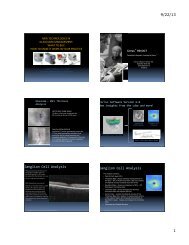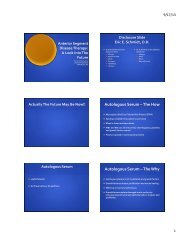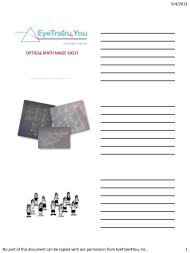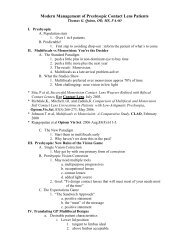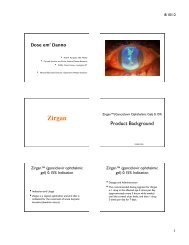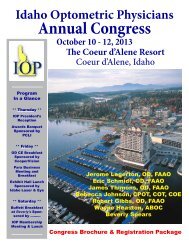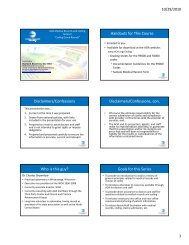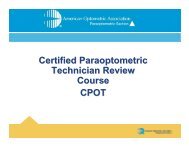You also want an ePaper? Increase the reach of your titles
YUMPU automatically turns print PDFs into web optimized ePapers that Google loves.
Sag (mm)0.000-1.450-3.7000 45 90 135 180 225 270 315 360Semi-Meridian (deg)8.0 Chord10.5 Chord13.5 ChordCalculating Sag at 3 “nodes”• BCR Mean 7.80 mm• Sag = 1.104 at 8.0 mm• RZD Mean = 0.850• Sag at 10.5 = 1.954 mm(1.104 + 0.850)• LZA Mean = 56°• Sag at 13.0 = 3.029 mm(1.954 + 1.075)BCR 8.0 Sag RZD8.0-10.5 ∆Sag LZA10.5-13.0∆ Sag6.60 1.350 0.650 0.650 48 0.7996.80 1.301 0.700 0.700 49 0.8317.00 1.256 0.750 0.750 50 0.8637.20 1.213 0.800 0.800 51 0.8967.40 1.174 0.850 0.850 52 0.9307.60 1.138 0.900 0.900 53 0.9657.80 1.104 0.950 0.950 54 1.0008.00 1.072 1.000 1.000 55 1.0378.20 1.042 1.050 1.050 56 1.0758.40 1.013 1.100 1.100 57 1.1138.60 0.987 1.150 1.150 58 1.1538.80 0.962 1.200 1.200 59 1.1949.00 0.938 1.250 1.250 60 1.2379.20 0.915 1.300 1.300 61 1.2809.40 0.894 1.350 1.350 62 1.3269.60 0.873 1.400 1.400 63 1.3731.450 1.450 64 1.421Asymmetric <strong>Scleral</strong> Contour• Deepest• Superior Nasal• Shallowest• TemporalNote: Inferior Temporalis not equal to superiornasal-0.050-0.100-0.150-0.200-0.250-0.300-0.350-0.400-0.450-0.500-0.550-0.600-0.650-0.700-0.750-0.800-0.850-0.900-0.950-1.000-1.050-1.100-1.150-1.200-1.250-1.300-1.350-1.400-1.500-1.550-1.600-1.650-1.700-1.750-1.800-1.850-1.900-1.950-2.000-2.050-2.100-2.150-2.200-2.250-2.300-2.350-2.400-2.450-2.500-2.550-2.600-2.650-2.700-2.750-2.800-2.850-2.900-2.950-3.000-3.050-3.100-3.150-3.200-3.250-3.300-3.350-3.400-3.450-3.500-3.550-3.600-3.650-3.750-3.800-3.850-3.900-3.950-4.000OD - Variation with meridianDual Axis Landing Zone• The Dual Axis feature allows the lens to have a varyingsagittal depth in one meridian compared to another whilemaintaining a spherical base curve• As a rule, the vertical meridian of the sclera is deeper thanthe horizontal. The dual axis feature maintains:• more uniform sag circumferentially• eliminates flexure• provides orientational stability that enables front surfacetoric or HOA correctionOpportunityA new scleral lens using the same logic and lexicon asParagon CRT:Base Curve RadiusReturn Zone DepthLanding Zone AngleDual Axis:Controls flexureProvides orientation and stabilityEliminates mid peripheral bubblesFront surface cylinder / decentered multifocalA scleral lens with edge lift:Tear exchangeEase of removalFitting <strong>Scleral</strong> <strong>Lenses</strong>Fitting <strong>Scleral</strong> <strong>Lenses</strong>1. Select parameters from the periphery tothe center• Landing Zone Angle must demonstrateedge lift and clearance at the 10.5 mmchord (50 microns)• Dx set with mean Landing Zone Angle• No edge lift = decrease angle• Excess edge lift = increase angle2. Select the RZD to provide total corneal clearance• Elevation data from corneal topography can beextrapolated to derive the sag at 10.5 mm• Sag of the optic zone at 8 mm derived from lookup tables using the base curve radius• RZD lifts the optic zone of the lens to causeoptic zone junction and lens apex to clear thecorneal surface by at least 30 microns• OZ touching = RZD too shallow• Bubbles under OZ = RZD too deep4



